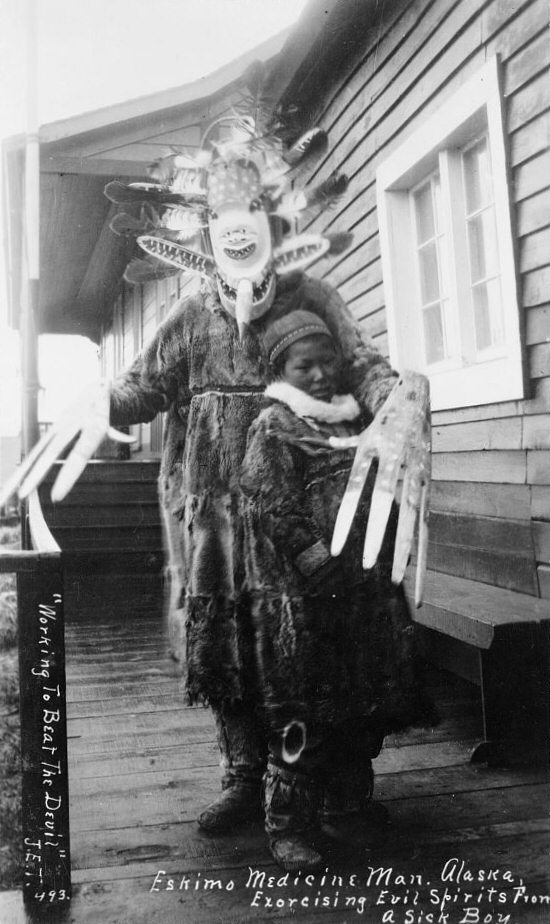by Jason Godesky | The shaman is an ambiguous figure in any tribe. He is touched by the numinous “Other.” The power to heal is also the power to kill, and the benevolent shaman is also the malevolent sorcerer. He wields a power that is frightening. In a tribal society where everyone belongs, it is the shaman’s burden to be the only one that is marginal–the only one that is shunned, alienated, and forever on the outside. The shamanic journey is very often described as a terrifying experience. The Ju/’Hoansi describe n!um as a burning liquid at the base of the spine; the trance dance allows it to boil up the spine, until it explodes out of the head. It is described as searing hot, as burning the spine; the explosion is described as immensely painful. Ayahuasca is the “Little Death,” and many experiences recounted with that particular brew are more vivid than my most terrible nightmares. This is the ordeal that the shaman undertakes for his community. Why would anyone choose such a life? They don’t; they are chosen. The shamanic sickness leaves them with a stark choice: become a shaman, or die.
How, then, do we explain this?
I share these stories to point out that it is a tricky endeavor to travel to a third world country and ask a total stranger for a spiritual experience. While many shamans undoubtedly come to their profession to help others, be aware that ayahuasca tourism is a thriving business in Peru, and that you will likely be treated as just that – a tourist.
The Teachings of Don Juan: A Yaqui Way of Knowledge reintroduced shamanism to the West, and began the trend of “neoshamanism.” Carlos Castenada’s ethneogenic tutelage to the Yaqui sorcerer, Don Juan, provided a mythic framework for the drug culture of the 1960s. The Teachings of Don Juan became an enormous success; and Castenada became a celebrity. In the popular mind, this association has continued–the shaman has been denigrated to some kind of sacred addict. In fact, even in Castenada’s own corpus, this error is corrected–though few pursue his work all the way to the last volume, Journey to Ixtlan, where he reflects:
My insistence on holding on to my standard version of reality, rendered me almost deaf and blind to don Juan’s aims. Therefore, it was simply my lack of sensitivity which had fostered [the use of the power plants].
 The role of ethnogens was relegated to its proper perspective by the work of Michael Harner, an anthropologist who sat on Castenada’s disseration committee–where he recieved a Ph.D. for Journey to Ixtlan under the title of “Sorcery: A Description of the World.”–before “going native” with the Conibo in Peru, and becoming a “white shaman.” It is with Harner’s accounts of his experiences with ayahuasca that the current trend of tourists has its roots. Harner’s The Way of the Shaman was a “how-to” guide for Westerners to achieve the shamanic state of consciousness, or SSC. With the publication of Harner’s first such guide (many more would follow), and the founding of the Foundation for Shamanic Studies, “neoshamanism” began.
The role of ethnogens was relegated to its proper perspective by the work of Michael Harner, an anthropologist who sat on Castenada’s disseration committee–where he recieved a Ph.D. for Journey to Ixtlan under the title of “Sorcery: A Description of the World.”–before “going native” with the Conibo in Peru, and becoming a “white shaman.” It is with Harner’s accounts of his experiences with ayahuasca that the current trend of tourists has its roots. Harner’s The Way of the Shaman was a “how-to” guide for Westerners to achieve the shamanic state of consciousness, or SSC. With the publication of Harner’s first such guide (many more would follow), and the founding of the Foundation for Shamanic Studies, “neoshamanism” began.
Daniel Noel’s The Soul of Shamanism: Western Fantasies, Imaginal Realitiescharts the history of neoshamanism, beginning with Mircea Eliade’s Shamanism: Archaic Techniques of Ecstasy. He discusses how Eliade unconsciously skewed that evidence away from the infernal and towards the celestial by putting together the biases revealed in his novels. He discusses in detail how Carlos Castenada made up the whole experience with “Don Juan”, and how that was revealed. He shows conclusively that “neoshamanism” is a fabrication of Western fantasies–the work of “shamanovelists” like Mircea Eliade and Carlos Castenada, and “shamanthropologists” like Joan Halifax and Michael Harner.
Today, “neoshamans” sell their services to strangers as “alternative medicine practitioners”–for a fee. They often operate alone. Shamans heal, but they never seek payment for it. They refuse to accept any gifts if the healing is not successful. And most importantly, shamans never work with strangers–they heal the members of their community. The community is essential: without a tribe, there is no shaman.
The Foundation for Shamanic Studies sells books and seminars to help their customers become shamans themselves. Shamans learn, first and foremost, from the spirits themselves. Neoshamans learn from audio tapes paid with shipping and handling.
Shamans undertake a perilous ordeal on behalf of their communities. Neoshamans commit the most cardinal sin of shamanism: to abuse the spirit world for a spiritual joyride, or worse still–for nothing more than their personal enlightenment.
A real shaman never journeys for himself; he journeys for others. “Neoshamans” become nothing more than ecstatic tourists, and the ancient traditions of shamanism become, in their hands, nothing more than the latest spiritual fad, another bullet point in “neopaganism” or “the New Age.”
Shamanism is profound. It is the original religion; it is hard-wired into the human brain. “Neoshamanism,” though, is nothing more than spiritual masturbation–it puts on the pretense of profundity, but in the end, it is nothing but a nest of hucksters and charlatans pretending to titles they have never earned.
 Native peoples are often deeply insulted by “neoshamanism,” and with good reason. Castenada couldn’t even be bothered to make sure his fictive account of “a Yaqui way of knowledge” mesh with Yaqui beliefs. Neoshamans strike native peoples as hucksters, charlatans and frauds who, having stolen all their material possessions, are now set to rob their culture, as well. Neoshamans desecrate the last thing they have left–their beliefs.
Native peoples are often deeply insulted by “neoshamanism,” and with good reason. Castenada couldn’t even be bothered to make sure his fictive account of “a Yaqui way of knowledge” mesh with Yaqui beliefs. Neoshamans strike native peoples as hucksters, charlatans and frauds who, having stolen all their material possessions, are now set to rob their culture, as well. Neoshamans desecrate the last thing they have left–their beliefs.
We, trapped inside civilization, have lost something vital. The shamanic sickness strikes as many of us as it ever has; only its cure is gone from us. The specific traditions of specific cultures are specifically adapted to their situations. We have no right to simply steal them. But we can learn from them.
First, we must build our communities. Without a tribe, there can be no shaman. Once there is a tribe, the shaman’s quest can begin.
Michael Harner was on the right track with his idea of “core shamanism,” though. We cannot simply steal from other cultures, but we can learn from them. A study of all of them and what they all share in common can create a base for us to work from. That base should prove sufficient for Second Shaman to learn the rest–from the spirits themselves.
There was probably only one First Shaman; but each of our tribes will have their own Second Shaman. It will be that individual in each tribe who works from a solid anthropological base, and from that foundation, reaches out into the realm of the spirit to help his community form their own, unique tradition.
In revealing the fictive, often deceptive origins of “neoshamanism,” Noel’s Soul of Shamanism is not being entirely negative. In these fictions, “shamanovelists” and “shamanthropologists” are engaging in the same kind of “imaginal realities” as shamans themselves. The important element is to be conscious of that. As he explained in an interview.
Neoshamanism is built on a cross-cultural fantasy that we can borrow eclectically and then homogenize the borrowings into an option Westerners can practice safely, quickly, and simply. Of course, the kind of neoshamanism I want to see develop is one that is less acquisitive toward “alien” cultures and more focused on possible Western resources, drawn on deliberately from an imaginal perspective growing out of Jung’s Western psychology.
We cannot simply take what we want from various cultures, trying to pick and choose the elements we prefer as at some kind of buffet. The intersection of those beliefs, though, echoes back to a common heritage of all mankind–a heritage we lost, and must desperately regain. We need to lay down the academic foundations, but it must be anhonest academic foundation–something that assiduously avoids the exaggerations and deceptions of “shamanovelists” and “shamanthropologists.”
Once that base is established, our own shamans can begin the great, ongoing work that awaits them: that of learning the rest from the spirits themselves, and learning how the visions of each tribe and each individual can coexist absolutely within their imaginal realities.